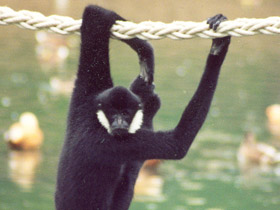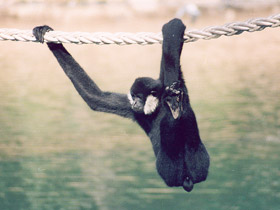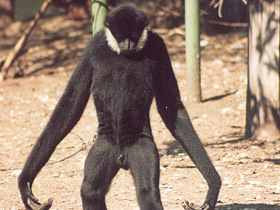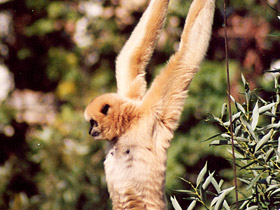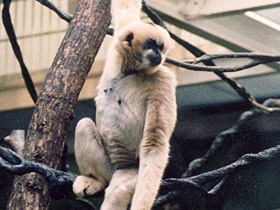The black crested gibbon (Nomascus concolor)
The black crested gibbon (Nomascus concolor) is a Critically Endangered species of gibbon found in China, Laos, and northern Vietnam, with four subspecies.
Taxonomy
The taxonomy of the species is confused. Previously grouped in the genus Hylobates, currently four subspecies are recognised.
- Central Yunnan black crested gibbon (Nomascus concolor jingdongensis), Yunnan province, China.
- West Yunnan black crested gibbon (Nomascus concolor furvogaster), Yunnan province, China.
- Laotian black crested gibbon (Nomascus concolor lu), Laos.
- Tonkin black crested gibbon (Nomascus concolor concolor), northern Vietnam.
Appearance and habitat
Nomascus concolor is a species of hominoid primate of the family Hylobatidae. Nomascus concolor is common in Southeast Asia, in China (Yunnan province), Laos, eastern Cambodia and Vietnam north of the Red River. These primates live in tropical and subtropical evergreen forests and are usually found in the upper part of the forest canopy. The body of Nomascus concolor is small and reaches a length of 45 to 64 cm (50 cm on average) and a weight of 6.9 to 10 kg (about 8 kg on average). Its arms are very long, longer than the legs, 2.6 times longer than the body length in females and 1.48 times longer in males. Nomascus concolor has a naked throat-resonator sac, with which they are able to produce very loud sounds. Unlike the other 5 species of the genus, Nomascus concolor has a tuft of hair protruding upwards on the top of the head, which extends in the centre of the head in males and on the sides of the head in females. For this reason, they are often referred to as crested gibbons. Interestingly, when young, the hair of females is completely black. However, as they mature, their coat colour becomes bright golden yellow or light yellow. Males remain black all their lives and have whitish fur only on the cheeks and head.
Lifestyle and nutrition
Nomascus concolor rarely descends to the ground, where it spends very little time. Nomascus concolor spends most of its time high in the treetops, where the branches are too thin to contain heavy predators, so it is protected from many potential enemies. Nomascus concolor feeds on fruits, plant shoots, leaf buds and flowers, as well as small amounts of insects and other invertebrates. However, soft, ripe fruits form the basis of the diet. Generally, all members of the family feed together on the same tree.
Behavior
Gibbons are forest dwellers and are well known for their habit of swinging between the branches of the rainforest on their long arms, a method of locomotion known as brachiation. Gibbons are also adept, however, at walking upright, both on the ground and in the trees. Black crested gibbons live in small family groups consisting of a monogamous male and female and their offspring; occasionally groups reportedly may contain additional mature females. These apes are predominantly arboreal and the group forages and sleeps amongst the trees. Led by the female, the breeding pair partakes in vigorous bouts of singing in the morning, which hauntingly echo through the forest. These 'duets' are believed to be essential in pair bond formation and reinforcement, and also serve to advertise the presence of the group within the territory. A single young is born every two to three years and the infant is usually weaned once it reaches two years old; Black crested gibbons feed preferentially on ripe, sugar-rich fruit, such as figs, but occasionally consume vitamin-rich leaf buds, and rarely eat animals.
Group living
Black-crested gibbons live arboreally in small groups, most of which consist of a pair of adults, one male and one female, and their offspring. It has been observed that some groups consist of one adult male living with two to four females and their offspring. The group could potentially include one infant, one juvenile, one adolescent, and one sub adult. Groups have been found to be territorial, like other species of gibbons. Territories are limited by the availability of the male for territory defense. Thus, group and territory size would be limited. With a large group, territory defense would not be favored by kin selection due to the group consisting of less-closely related individuals. Though the research is not explicit, there can be some assumptions made about altruism within groups. Since the majority of groups are living in monogamous relationships with both males and females displaying aggression when another individual enters, it is likely that kin selection plays a major role in determining behavior of the group. Kin recognition is thought to be favored for maternal-offspring relationships. This is largely due to primates' uncertainty over paternity, even in pair-bonding species due to female promiscuity. Social behaviors within groups will evolve according to Hamilton's rule.
Mating
Gibbons were previously reported to practice monogamous sexual relationships. They are known to form pair bonds, as well documented in the majority of gibbon species. Upon the discovery of single male, multi-female living groups, the question arose to determine if all females were mating. The observation that offspring of similar ages lived within a multi-female group confirmed that polygyny did in fact occur. The current hypothesis remains that both monogamous and polygamous relationships exist. There may be various selection pressures for polygyny within previously monogamous groups. Parents tend to be hostile towards maturing offspring, with males leaving the group more quickly than females do. Yet, upon tolerance by the mother, adult female offspring may remain in the group, as the group continues to forage and feed as family members. The mutual tolerance of females is likely to be caused by "weak territoriality of females". Further selection occurs due to the birth interval for a single female averaging 2–2.5 years. Male fitness would benefit from inseminating other females during a birth interval. This hypothesis is supported by the large scrotal size allowing for increased sperm production. Other observations have been made that males will share child carrying to place less of a burden on the female, delaying her interbirth time. The conflicting observations support the hypothesis that black-crested gibbons demonstrate both monogamous and polygamous sexual relationships.
Singing
All gibbon species are known to produce loud and long song bouts, lasting for 10–30 minutes. The black-crested gibbon sings in the morning, sometimes in duets initiated by the male. The males choose the highest tree branches, often near ridges. The songs are thought to be used for resource defense, mate defense, pairbonding, group cohesion and mate attraction.
Conservation
The black crested gibbon is listed as critically endangered on the IUCN Red List. An estimated 1300 to 2000 individuals are left in the wild. The western black crested gibbons were included on the State Forestry Bureau of China's list of 12 flagship and keystone species for biodiversity protection in 2021. While under protection, there was still a noticeable decline in population size at Wuliangshan National Nature Reserve. It was discovered that the gray langurs are suppressing the black crested gibbon's potential recovery. The gray langurs and black crested gibbons have similar diets and ranges; however, gray langurs have an advantage by having a more comprehensive dietary list, a larger group, and faster life history. The black crested gibbon inhabits the evergreen broad-leaved forests that take a long time to regenerate, making it challenging for the gibbons to connect with other groups. Ecological corridors were put in place in the Hengduan Mountain in China to help restore connections between different groups, increase overall well-being, and decrease the risk of extinction.

















